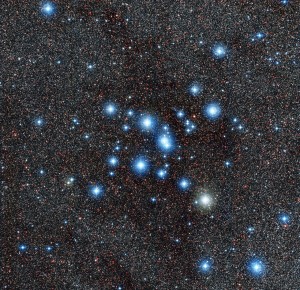Podcaster: Avivah Yamani
Title: Space Scoop: The Many Faces of our Night Sky
Organization: Astrosphere New Media
Link : astrosphere.org ; http://unawe.org/kids/unawe1406/
Description: Space scoop, news for children.
Bio: Avivah Yamani is a Project manager of 365 Days Of Astronomy
Today’s sponsor: This episode of “365 Days of Astronomy” is sponsored by — no one. We still need sponsors for many days in 2013, so please consider sponsoring a day or two. Just click on the “Donate” button on the lower left side of this webpage, or contact us at signup@365daysofastronomy.org.
Transcript:
This is 365 Days of Astronomy. Today we bring you a new episode in our Space Scoop Series. This show is produced in collaboration with Universe Awareness, a program that strives to inspire every child with our wonderful cosmos.

Messier 7 is a cluster of stars that can be seen easily with the naked eye. You will find the cluster in the “stinger” of the constellation many of us know as Scorpius (the Scorpion). Credit: ESO
Unlike many other subjects, like history and mathematics, science doesn’t have to be learnt from a book, you can really experience it. After all, science is the study of the world around us.
So, how can you “experience” astronomy? Well, like all areas of science, by making observations. Take Messier 7, the cluster of stars in this photograph, it can be seen easily with the naked eye. You will find the cluster in the “stinger” of the constellation many of us know as Scorpius (the Scorpion).
I say ‘many of us’ because the constellations are like secret agents, they take on many different names and characters as you travel around the world. For example, in Indonesia the Javanese people call Scorpius ‘the leaning coconut tree’. And native tribes in South America see the stars of the constellation in the shape of a ‘water snake’.
A scorpion is perhaps this constellation’s oldest identity, however. It was first used in Sumer, a civilization that existed 5000 years ago!
An interesting feature in this picture is the cosmic dust streaking across the background. It’s tempting to assume this is leftover from the gas cloud that formed Messier 7, but the streaks actually have nothing to do with those stars at all.
The Milky Way Galaxy has made almost a full rotation since this cluster formed 200 million years ago. The movement of the Galaxy will have shuffled and reorganized the stars and dust quite a lot, separating and scattering the dust over the millennia.
Cool Fact: Why don’t you go out and see this constellation for yourself? There are plenty of websites show you what is in your night sky. One example is ‘Planetarium’, which you can view at http://neave.com/planetarium/.
365 Days of Astronomy is a community podcast made possible thanks to the contributions of people like you. Please consider donating at 365DaysofAstronomy.org/Donate
End of podcast:
365 Days of Astronomy
=====================
The 365 Days of Astronomy Podcast is produced by Astrosphere New Media. Audio post-production by Richard Drumm. Bandwidth donated by libsyn.com and wizzard media. You may reproduce and distribute this audio for non-commercial purposes. Please consider supporting the podcast with a few dollars (or Euros!). Visit us on the web at 365DaysOfAstronomy.org or email us at info@365DaysOfAstronomy.org. In the new year the 365 Days of Astronomy project will be something different than before….Until then…goodbye


Trackbacks/Pingbacks